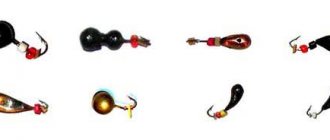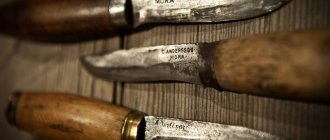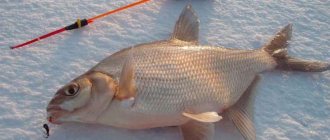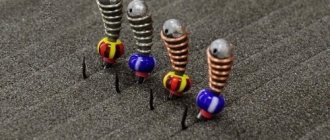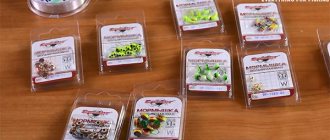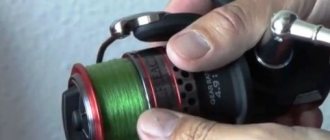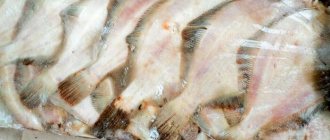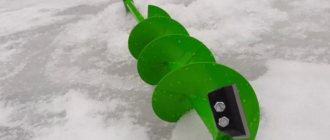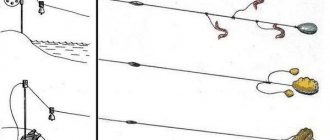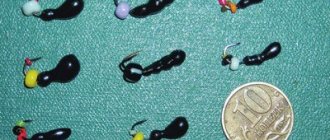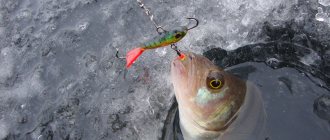This method of fishing with a jig is considered one of the most popular, and it is unlikely that there will be a person who has never heard of what a jig is. And there’s nothing to say about fishermen, and it doesn’t matter if you’re a beginner fisherman or with a decent amount of experience behind you. True, things are a little worse when talking about the types and purposes of a specific jig model, albeit the most popular one.
Not everyone has the idea that jigs come in the form of insects, and to attract fish you need to imitate the movement of the exact insect that the jig resembles.
Thus, a jig is an artificial bait that does not involve the use of live bait, attracting fish with its design, appearance and unique game.
Operating principle
The catchability of a jig is based on the following factors:
- the basis is a sinker (different in shape, design and materials), to which a hook is attached (single, double or tee, different in size);
- through a hole in the load, or a special loop, it is tied to the fishing line;
- Due to the correct twitching, the movement along the bottom of various insects or mollusks that are of edible interest to fish is imitated.
A special property of the baits described is that they absolutely do not require any bait. Its versatility lies in the fact that it can be used for fishing in both winter and summer.
Types of baitless jigs for catching winter perch
Friends, do you know all the types of baitless jigs that are used for catching perch in winter? No trick question. One day, out of curiosity, I decided to make a list of famous baits. I didn’t look on the Internet, left it for later, and went straight to the fishing store. How did it all end? I gave up this idea. However, you still need to know the basic types.
One main difference between a baitless, or reelless, jig used for catching perch is the ratio of the body of the bait and additional pendants that attract fish (cambrics, beads, chain links, multi-colored disks).
It's worth getting a little better. The name “nozzleless” is conditional. You understand that if there is a hook, then it is possible to attach animal or vegetable bait. But that’s what makes fishing interesting, when it is possible to fool the fish not with the taste of bloodworms or maggots, but with the skill of the fisherman.
And you can catch not only perch. Dace, sorog, grayling, whitefish, and bream respond well to such jigs. But, due to its wide distribution and frequency of catching, perch is the main trophy for which people deliberately go fishing with a reelless fish.
It is unlikely that it will be possible to characterize the entire range of types of baitless jigs used in fishing. Their great multitude will not allow this to be done. But I will try to describe the most common ones, which I successfully use myself, in this publication.
«Devil»
A most interesting group of baitless jigs. The great variety is due to the different variations in body length, the tees used, which can be “dead” fixed in the body of the bait or located in a flexible connection with the body and decorated with specially selected colored beads and cambrics. Along with the “witch,” the “devil” is my favorite mothless.
The external shape has many variations - from barrel-shaped to elongated, carnation-like. With or without pronounced taper.
The choice of an angler is determined by personal attachment to one form or another; some compare it with the activity of the perch, the time of day and the month of winter.
For fishing with the “devil”, haste is inappropriate. The bait requires smooth low-frequency oscillations and a leisurely rise from the bottom to the edge of the hole. During the wiring, pauses are required, during which the perch often attacks. It’s somewhat similar to fishing with a wobbler, only the range of movement is different.
To effectively fish a hole, anglers often use the “locomotive” method, when several “devils” are tied to the main line.
«Uralka»
A widely used nozzle-free jig, shaped like an elongated drop. We can say that the “Uralka”, or “Ural”, is not only a classic in winter fishing, but also, probably, the prototype of all other forms of reelless jigs and jigs that require additional bait from animal or plant food.
Easy to learn, forgives absolutely any mistakes of a novice fisherman. Works from the beginning of freezing until the last ice. Even in the dead of winter it can bring joy.
It has a whole line of sizes, so it’s not difficult to choose a jig for a certain depth and tackle. Shows good results in catching perch in currents and calm waters
“Ant” is a nozzle-free jig with a segmented body and its appearance reminiscent of an ant. In different regions you can find a huge number of variations in shape. They are often equipped with beads, but it happens that the bait works without additional attachments. This is probably why the jig has its admirers all over the country.
Regardless of their size, the “ants” perfectly provoke perch throughout the winter. Capable of fishing even at great depths.
Perch prefers fast, high-frequency game. By reducing the pace of fishing, the likely by-catch will be bream or bream.
«Goat»
As much as I would like to say that the “goat” is a common nozzle-free jig, but judging by the fact that the neighbors in the holes are not particularly fond of it, I will keep silent. It probably depends on the region. A wide variety of shapes and sizes, color elements of equipment, and, like a business card, the presence of two rigidly fixed hooks.
Judging by posts on forums, each form of “goat” has its adherents.
I often use it as an addition to the “locomotive”. The jig is predisposed to low-frequency play, which is why it is used together with the “devil”. But, as practice has shown, spruce and track respond to it more often than perch. But during a period of complete lack of bites, it happens that it works miracles. It doesn’t bring mountains of fish, but it can always take you away from zero. Especially when something alive and tasty is hung on a hook.
«Witch»
The most structurally complex nozzle-free jig. Previously, a variation of the “devil”, which had four hooks, was called a “witch”. Currently, four hooks have been replaced with three movable ones. Not everyone can make their own jig. very jewelry work.
The body of the “witch” is a cone-shaped weight made of lead or tungsten. In the upper, widest part, on a special mount, there are three movable hooks, decorated with cambrics and beads. Designs are constantly being improved. Now, in addition to special grooves in the body of the bait for hooks, stoppers have also been added. Their role is to limit the stroke of the hooks when moving.
Those who have already tried the baitless “witch” for perch know how effective it is. And not only perch is interested in bait. At the end of winter, when the dace moves from the river to oxbow lakes, channels and lakes, this reelless jig can force the fisherman to put all the other jigs back in the box. You just have to choose the pace of the game.
The list does not include “bugs”, “soldiers”, “cosmonauts”, “bananas” and many other baits. You can find information about them on the Internet, or, a little later, on the pages of my blog. But I’m afraid that I still won’t be able to put on display all the types of baitless jigs skillfully used by fishermen to catch perch and other fish, predatory and peaceful.
NHNCH, Friends. Regards, Oleg
There is no such thing as too much information
Winter nozzle jigs
They can be called the ancestors of ice fishing, because it arose to catch passive fish in the winter, when activity is very low. And for this purpose they combined the sinker and the hook. The basic principle of their classification is related to weight:
- light weight (for fishing in shallow places and where there is no current),
- average (they are also called universal, if you have some experience you can fish under any conditions),
- heavy (due to their weight, they are convenient for use in areas with fast currents or great depths).
Undoubtedly, jigs made from tungsten blanks are recognized as the best for their distinctive properties:
- quick descent to the bottom while maintaining a stable position,
- feature of the game, so attractive to fish,
- at the same time they are small in size (due to the high density of the material),
- reliable and durable.
Nozzleless jigs. Types, description
- VK
When the time comes for active ice fishing, anglers rush to replenish their stocks with new models of baitless jigs. Many winter fishing enthusiasts prefer to make their own baits and achieve excellent results in this field. But making a catchy bait is only half the battle; it also needs to be presented correctly.
Simple jig "Devil"
Jig "Devil" simple weight - from 0.3 g. The most common type of jig with three hooks. Suitable for catching large roach, bream and other fish. A larger jig (from 1.5 g and above) is a good pike perch bait.
Mormyshka "Devil" compound
Jig "Devil" composite weight - from 0.8 g. Works well in strong currents and great depths when hunting for large fish (bream, ide).
Jig "Devil" curved
Curved jig "Devil" weight - from 0.5 g. It has a more varied game than the classic bait. Shows its best qualities most effectively in weak currents.
Mormyshka "Mini-Devil"
The “Mini-Devil” jig weighs 0.2-0.3 g. Thanks to its low weight and modest size, it attracts the attention of fish quite well, even if it is simply raised or lowered in the water column at a minimum speed. Unlike larger “devils”, “mini” ones can be used to catch small roach and perch in the coastal zone. A small piece of lead, equipped with three hooks, can help out an angler even during the most unstable bite.
Mormyshka "Twisted"
Mormyshka "Twisted" weight - 0.1-0.15 g. This ultra-light bait is especially good for catching medium-sized perch in shallow areas of low-flowing reservoirs.
Mormyshka "Bedbug"
Jig "Bedbug" weight - from 0.5 g. The bream jig works most effectively in the bottom layer. Low-frequency bait (60-80 vibrations per second) makes complex oscillatory movements in horizontal and vertical planes. It is used in standing and low-flowing reservoirs at great depths.
Jig "Medusa"
Jig "Medusa" weight - 0.3-0.6 g. Imitates the behavior of an aquatic organism, smoothly moving its legs. Fishing objects: perch, roach, bream, etc. Used in currents and in still water. The measured, quivering movements of the bait attract perch and large roach. Retrieving pace: smooth rise and fall with a small amplitude of nod oscillations.
Mormyshka "Tenka"
Jig "Tenka" is a large jig (1.5-2 g), more like a spoon, designed for catching perch, ide, large roach (on the last ice). Used in weak currents and standing water. “Tenka” is played like a regular jig, with a frequency of two to three vibrations per second and with increased amplitude. After three or four retrieves, it is useful to make one or two strokes, working the bait like a spinner.
Mormyshka "Cobra"
Jig "Cobra" for perch and ide; weight -0.5-0.8 g. Wiring - energetic “sawing” with fast vertical movements.
Mormyshka "Goat"
The Goat jig is a very common bait; weight - 0.3-0.8 g or more. Suitable for most winter active fish. The body of the bait in most models has a smooth bend. The inside of the “goat” is in most cases made of copper or brass foil and polished to a shine. The outer surface of the body is painted black or dark green. With correctly selected wiring, the game of the “goat” resembles the movements of an amphipod. This technique is effective: a fairly heavy jig crashes into the ground and begins to vibrate quickly, then with an amplitude of 34 mm it comes off the ground and begins to rise. The wiring speed can be either medium or fast.
Movable jig "Goat"
The “Goat” jig has a moving mass of 0.5 g. It has a more varied game. An additional game element in the form of large beads increases the chances of catching a “white” fish.
Mormyshka "Chain"
The “Chain” jig is a classic no-attachment jig. Its shape and size are selected in such a way that during wiring it produces the highest vibration frequency (over 200). This requires the fisherman to have certain qualifications. The bait, vibrating at a high frequency, is slowly and smoothly raised to a distance of 1 m or more from the bottom, then lowered in the same way. Very often bites occur at the top point of the rise. It is recommended to sometimes slow down the rate of oscillation of the jig, resuming the previous rhythm after 7-10 seconds. This technique often leads to success. Large perch (“humpbackfish”) are especially partial to the “chain,” but in the middle of winter they are half asleep. It is quite difficult to get him to try the bait; sometimes you have to sit over the hole for at least 15-20 minutes.
Mormyshka "Boat"
The “Boat” jig is used at depths of up to 2.5 m and works most effectively in shallow water. Weight - 0.3 g. More than half of the body volume of the jig is occupied by polymer material. Fishing objects: perch, roach, bream and other fish. The bait is balanced so that it works equally effectively with any fishing method. Swaying lazily as it rises slowly, it will attract wary roaches. With more intense fishing, it will have an irresistible effect on large perch and ide. A high oscillation frequency is a prerequisite for the successful use of most nozzle-less jigs. The “boat” allows you to reduce the oscillation frequency to minimum values without loss of catchability. This is very important, since not all anglers can maintain a high retrieve rate. The fish takes this jig boldly, mistaking it for live food. Due to its design features, the bait creates vibrations very similar to vibrations emanating from a real aquatic organism.
Flat jig "ant"
Flat jig "ant" weight - from 0.3 g. This modification of the classic "ant" has a more varied play pattern.
Mormyshka "Donkey"
Jig "Donkey" weight - 0.5 g. Used in currents and in standing water. Fishing objects: perch, roach, bream and other fish. The soft dark gray color of the lead alloy does not alarm finicky underwater inhabitants (which is especially important in “overfished” reservoirs). Deep “grooves” on the “back” create an interesting effect: when reeling, the jig makes noise, attracting fish from afar. The bait works quite successfully in gentle currents; the fishing is carried out near the bottom. Using the force of the current, tapping the bottom in small “steps”, the jig can be forced to move further and further away from the hole. Thus, a significant bottom area of the reservoir is fished, which significantly affects the catch. “Scratching” along the bottom and raising clouds of turbidity, the “donkey” provokes both pike perch and bream to bite.
Mormyshka "Ant"
Mormyshka "Ant" weight - from 0.4 g. It is possible to successfully catch the "ant" in large reservoirs. Before the flood, roaches begin to concentrate at the mouths of rivers flowing into the reservoir. The movement of the roach takes on a massive character, and it begins to move upstream of the river. Having encountered an “ant” with a black body and a white bead as a bait on its way, a large roach greedily grabs this “decoy.”
Mormyshka "Motylevaya"
Mormyshka "Motyleva" weight - 0.15-0.2 g. Ultra-light shallow-water bait with an elongated hook shank. The main working element of the bait in this case is a plastic bloodworm. The wave-like vibrations of the silicone tip of the imitation bloodworm, mounted on the hook of the jig, have a favorable effect on the bite. A medium-sized fish swallows the bait with great pleasure. Small roach pays increased attention to the oscillating silicone tail, pulling the plastic bait off the hook, which causes many empty hooks.
Mormyshka "Moth"
The moth jig has a low mass (0.1 g) and is used in the smallest places. Thanks to its segmented body, the bait resembles a large bloodworm. When fishing for perch, the “moth” is used at a hard, aggressive pace. Sometimes the perch bites sluggishly on a jig with a bait, while at the same time the bites on a “moth” are more decisive. Retrieving is carried out by lifting the jig up to the very edge of the ice, then slowly lowering the bait to the bottom, and the process is repeated. Sometimes, especially on frosty days, the activity of the perch increases, and it boldly swallows the “moth”, and the nod detects a sharp bite, as if on a spinner.
Mormyshka "Drobinka"
The “Drobinka” jig is articulated, weighing from 0.3 g or more. Quite a universal bait. Depending on the performance, it actively plays at different depths and attracts a variety of fish.
Jig with beads
Jig with beads at shallow depths and in the absence of current, some fishermen use a tungsten jig of a streamlined shape, weighing 0.2 g, equipping it with two relatively large plastic beads. The bait does not look very presentable, but it is catchy. Yellow and white colors of plastic baits attract roaches well. The game of this “reelless” jig is significantly influenced by the movements of the beads, which to some extent compensates for the intermittent movements of the jig itself. The body of the bait, as it were, sets the main tone of the game, “swinging” the voluminous but light baits.
Jig "Ant" tungsten
Tungsten jig "Ant" weight - up to 0.6 g. Used at significant depths. Thanks to the low frontal resistance, it can work stably in medium-force currents. Effectively used when fishing for bream, ide, large perch in holes with weak currents adjacent to river islands.
Mormyshka "Fly"
The “Fly” jig weighs 0.5 g. A hook No. 3 with a slight overlay in the fore-end area is soldered to a copper or silver-plated polished crown. Fishing objects: perch, medium-sized roach (along the first ice). During an accelerated rise, the jig moves away from the hole, and the excited perch willingly grabs the shiny “fly”. Sometimes the “fly” is jerked sharply several times, as a result of which it makes wide circular movements. If you return to normal fishing after this, you can provoke another apathetic perch to bite.
Ant jig "goat"
Ant “goat” jig weighs 0.15-0.17 g. This unique symbiosis of two designs has proven itself to be excellent when catching active roach and perch. The jig has a curved cut located in the upper part of the body.
Mormyshka lead body of an “ant”
Jig - the lead body of the “ant” consists of three segments arranged in an arcuate manner; weight - 0.15 g. The largest segment has a flat cut. This feature allows the jig to make additional vibrations in the horizontal plane. The game is more lively than that of an ordinary “ant” and has an excellent effect on the catch.
Mormyshka "Donnaya"
The “Bottom” jig weighs 0.2 g. The weight of the “reelless” jig is made in the form of a disk with a flat bottom. A hook with a plastic imitation of a bloodworm is movably attached to the eye of the jig body. “Bezmotylka” is designed for fishing in the bottom layers of water. If the jig begins to hit the bottom, nearby fish watch what is happening with interest. When the “bottom fish” slowly emerges from the cloud of rising turbidity, it immediately finds itself in the mouth of a curious perch. The jig is not raised above 5-7 cm. In addition to roach and perch, it is good for catching bream in gentle currents. The movable hook is fully equipped to meet fish from different directions. In large lakes, towards the end of winter, the stomachs of large perches are filled with black bugs. For a reason unknown to me, water insects accumulate under the ice in large quantities. Perches, having discovered an accumulation of easily accessible food, radically rearrange their diet.
Lightweight tin jig
A light tin jig (weight - 0.15 g) shows a phenomenal result in such conditions. With sharp swings with an amplitude of 57 cm, the “rewinder” makes throws in the horizontal plane, reminiscent of the movements of a small bug. The perches present nearby do not ignore the daring behavior of the small “insect”.
Mormyshka "Cone"
Jig "Cone" lead jig; weight - 0.15 g. Well-balanced design responds equally well to different wiring rates. Large beads have a noticeable effect on the movements of the bait. The “cone” is universal; you can use it to conduct reconnaissance in an unfamiliar body of water.
Mormyshka "Lentil" made of plexiglass
The “Lentil” jig made of plexiglass is placed on a separate leash 5-10 cm above the main bait. Works in tandem with the “devil” or any other “mothless”. Due to its small mass (less than 0.1 g), the fish easily draws it into its mouth and on some days more than half of the bites occur on the “lentil”.
Mormyshka "Malek"
Jig "Malek" is a large lead jig (weight - 0.6-0.9 g) for river fishing. Features of the package: a strip of white goat hair is glued to the back of the bait. A section of a river with a moderate current is examined using the method of stepwise wiring, floating a jig downstream. Fishing objects: pike perch and large perch.
Brass jig "bug"
Brass jig "bug" (weight - 0.3-0.5 g) on pebble river riffles. Fishing becomes especially successful when you manage to find a small pit located behind a decent boulder.
Mormyshka "Pendant"
The “Pendant” jig is an almost weightless design consisting of a hook No. 3.5 and soft plastic balls. Used in combination with a heavier lower jig (“devil” or “goat”). It is great for catching almost any available fish.
Mormyshka "Strelka"
Jig "Strelka" weight - 0.2 g. A fly with three tail tassels is tied to the shank of the hook. “Strelka” performed well on a rocky bottom in places with weak currents. It happens that the bait knocks on some overgrown stone located directly under the hole. In such a situation, bites follow one after another. The “arrow” sliding along the hard slope of an underwater obstacle resembles the movements of a natural prototype (dragonfly larva).
Jig "Bormash"
The Bormash jig is similar to a crustacean that lives under the boulders of river rapids. "Bormash" is effective in closed reservoirs, backwaters and reservoirs. Allows low-frequency wiring (90-100 vibrations per second). A synthetic tape is wound around the lead body of the jig. The fish reacted very favorably to such an innovation. "Bormash" has proven itself well when catching perch, roach and bream.
Mormyshka "Caterpillar"
Jig "Caterpillar" weight - 0.3 g. Lead wire is wound onto a hook No. 3.5 with an elongated shank; the interturn space is filled with squirrel fur fibers. As a result, the “caterpillar” makes smooth, slow oscillations during the drive, which cause confident bites from roach and bream. However, due to the increased resistance of the aquatic environment, immersion at the starting point of the wiring occurs slowly, so the “caterpillar” is effective mainly at small and medium depths.
Hanging hook
The advantage with a hanging hook is the high mobility of the main attracting element. During periods of increased feeding activity, perch eagerly grabs a hook wagging in all directions with baits strung on it.
Related articles:
Types of nods
Mormyshka "devils"
Winter nods
Finding and catching perch in winter
Summer jigs
The difference between a summer jig and a winter jig is not so great. Considering the weather conditions (temperature, windiness, etc.), during this period there is an incredible amount of fry, the use of small jigs is not recommended. In warm weather, large jigs are most relevant.
In addition, most of them are colored in red-brown shades (pleasant for crucian carp, pike perch and perch). The species do not differ from winter ones, except that the pattern can imitate the shell and imitate representatives of arthropods.
And the most important thing is that you need to approach the selection of a rod, line and nod more responsibly.
Tips for choosing jigs
When choosing a particular jig, of course, it is better to consult with experienced fishermen to find out on which body of water which is the most catchy. Besides this, other characteristics are also important:
- hooks: strong, sharp and relatively thin (it is better if they are made of steel wire);
- material: the main ones are tin, lead or tungsten; in addition, copper, chromium, silver, brass are used (they are less susceptible to corrosion);
- product color: black (universal, best used in spring); copper and its shades (in depth); cold shades (for clear waters); green and brown (for perch and roach); light colors (for ice fishing, if the river is covered with a thick layer of snow); shiny (early morning) and dull (during the daytime);
- size (weight): at depth or in fast currents, large and heavy jigs will be required, and medium or small sizes with low weight will be convenient when fishing in shallow water (it is better to have jigs of different sizes and weights);
- shape: noticeable, “ball” and “droplet” will be universal (popular in ice fishing), flat creates a lot of turbidity (suitable for roach and perch), conical will sink into the muddy bottom.
TOP 7 best mothless baits
It’s hard for beginners to decide which baits to add to their arsenal. Even experienced fishermen who prefer to fish with a jig with bait will not always be able to choose the most catchy bait of this type. The rating, which was compiled based on the reviews of the majority of experienced reelless fishermen, can help with this.
Pellet
This reeler is universal; its ball-shaped body attracts almost all types of fish, which are caught both in summer and winter. The most attractive shot is for perch and roach.
A drop
The second most popular is the mothless moth with a teardrop-shaped body. This jig is distinguished by its versatility in use; it is attractive to almost all types of fish in any body of water.
Uralka
The mothless moth with this name has a teardrop-shaped elongated body with a slight bend. Attracts different types of fish; roach, crucian carp and perch respond well to it.
Goat
This type of rewinder is similar in shape to the Uralka, but the difference will be a double hook, this is precisely what makes it special.
Ant
This jig has a body consisting of several segments, most often there are from 2 to 4 on one product. The name comes from its external similarity to the insect of the same name.
Klopik
This jig was very popular several decades ago. It must be carried out with a wide amplitude, but slow movements. In terms of catchability, this jig is inferior to those described above, but with a bad bite it can create a sensation.
Tying methods
Despite the variety of baitless jigs, there are a couple of methods for tying a line. The determining factor is the presence (or absence) of a hole in the body of the jig.
If there is one, then the line is wound through it from the front side, and then tied at the base like a regular fish hook with a self-tightening knot. If there is a special loop or eyelet, then pass it through it.
Jig fishing technique
When you take a jig for the first time, you ask yourself the question: how to fish with no-attachment jigs?
Note!
Reelless fishing in winter - secrets and principles of fishing for beginners. 110 photos and videos of winter fishing with a reelless baitFishing with a balance beam in winter - a detailed guide and important nuances of fishing with a balance beam during winter fishing (115 photos)
How to attach live bait to a girder - the best methods and step-by-step description of how to properly attach live bait (115 photos and videos)
To achieve the desired result, that is, catch a fish, you must strictly perform the following actions in a certain order:
- immerse the jig in the water,
- lead the bait
- play with bait (special actions that force the bait to move in a certain way),
- hook (necessary for a tighter hook on the fish),
- fish out (carefully lifting a fish caught on a hook by the line),
- removal from the hook (especially if the fish is predatory).
Features of catching roach with a jig without a nozzle
The most productive time for roach fishing with jigs is February. Interestingly, at the end of winter, large roaches weighing from 300 grams gather in flat sections of rivers with a depth of 4-6 meters. If you catch a school of roach, you will remember such fishing for a lifetime. One by one, the fish literally take turns sitting on the hook. Naturally, on such fishing trips there should be a good supply of jigs. It doesn’t really matter what kind of jigs, the main thing is that there are enough of them. It happens that you have to pull the fish out by force, and sometimes the fishing line is cut on a shell or clings to a snag. In such cases, it is better to use a stiffer fishing line, or fluorocarbon.
Roaches sometimes tear devils and jigs from thin fishing lines. In this case, it is better to use a thicker fishing line of 0.12-0.14 mm. If the bite is “like on black stones,” then such nuances as hundredths of a millimeter will not play a decisive role.
The most important point when fishing with a jig without a nozzle is to determine the bite. As a rule, large roach smoothly bends the nod. At the moment of bending you need to make a hook. If a small perch or roach bites, the nod will twitch sharply. The pike perch simply presses the nod to the hole.
The most difficult case is the bite of a medium roach. You need to learn to identify them. When the bait oscillates, the tip rises and falls. When the roach bites, the amplitude of these oscillations changes. The nod rises a little higher than usual, and when lowered it stops a little. At this moment you need to make a hook. You can try to hook while raising the nod. If you miss these nods, the roach will spit out the jig and leave. Here you need to capture this moment. In practice, it is not always possible to do everything correctly. Sometimes you have to pick up jigs. If the bites are sluggish, then it is better to use the smallest ones. If the fish takes confidently, then you can enlarge the jig.
In general, catching roach with jigs is quite a difficult task, especially in winter. It’s not enough to discover its resting place and make it peck. It is necessary to clearly define the moments when cutting should be done.
Proper storage
Despite the fact that jigs are made of hard materials, they can be damaged if improperly stored or transported.
You can buy it in a store, or you can use a homemade one that is the right size for your clothing pockets.Also, if they are folded incorrectly, they can get caught among themselves and, during fishing, create inconvenience. To do this, use various organizers (tightly closing boxes with a rigid body).
By gluing foam rubber to the bottom of the box, into which if you stick them, they will not cling to each other (accordingly, the hooks will remain sharp, and even more so will not break).
